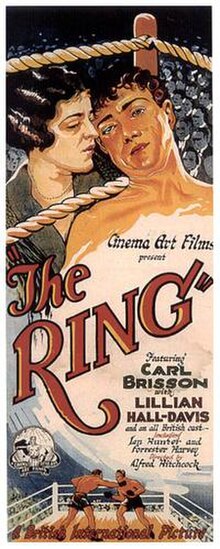The Ring (1927 film)
| The Ring | |
|---|---|

Theatrical release poster
|
|
| Directed by | Alfred Hitchcock |
| Produced by | John Maxwell |
| Written by | Alfred Hitchcock |
| Starring | |
| Music by | Xavier Berthelot (uncredited) |
| Cinematography | Jack E. Cox |
|
Production
company |
|
| Distributed by | Wardour Films |
|
Release date
|
|
|
Running time
|
89 minutes |
| Country | United Kingdom |
| Language | Silent film with English intertitles |
The Ring is a 1927 British silent sports film directed and written by Alfred Hitchcock and starring Carl Brisson, Lillian Hall-Davis and Ian Hunter. It is one of Hitchcock's nine surviving silent films. The Ring is Hitchcock's only original screenplay although he worked extensively alongside other writers throughout his career.
The film was made at Elstree Studios by the newly established British International Pictures who emerged as one of the two British major studios during the late 1920s and began hiring leading directors from Britain and abroad. It was Hitchcock's first film for the company, after joining from Gainsborough Pictures. It was also the first ever film to be released by the company.
Hitchcock was only 28 years old when he directed The Ring, but this was already the young filmmaker's fourth film. Hitchcock regularly attended boxing matches in London where he lived and he was struck by the fact that a good number of the spectators appear from good backgrounds and dressed in white. He also noticed that fighters were sprinkled with champagne at the end of each round. It was these two details that persuaded the young Hitchcock to start work on The Ring.
After directing Downhill and Easy Virtue, two stage adaptations for the Gainsborough company, Hitchcock was frustrated and jumped at the chance to develop an idea of his own. Surprisingly, The Ring is Hitchcock's one and only original screenplay, although he worked extensively alongside other writers throughout his career. Colleagues at the studio were impressed by the neatness of his script and its writer's grasp of structure. What's more, writing for silent films came naturally to a director who already thought in visual terms. He was much less comfortable with dialogue, which goes some way to explain why he took no sole writing credit in any later films.
...
Wikipedia
